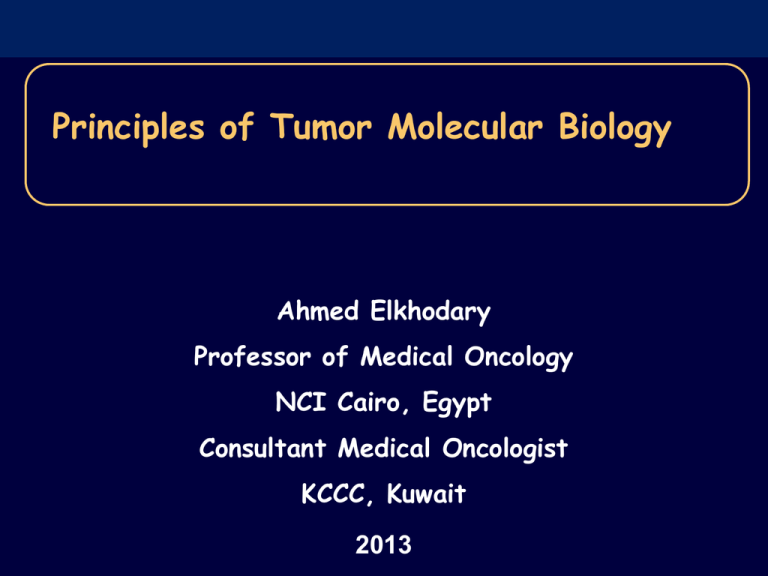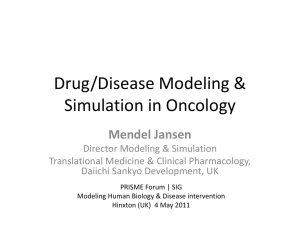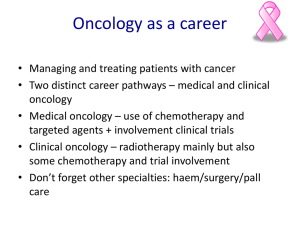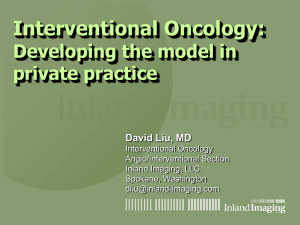
Therapeutic Decision Making in Advanced NSCLC: A 2012 Perspective
clinicaloptions.com/oncology
Principles of Tumor Molecular Biology
Ahmed Elkhodary
Professor of Medical Oncology
NCI Cairo, Egypt
Consultant Medical Oncologist
KCCC, Kuwait
2013
Cancer cells developed capacity for largely unregulated
growth
Therapeutic Decision Making in Advanced NSCLC: A 2012 Perspective
clinicaloptions.com/oncology
Characteristics of cancer cells:
•Capabilities of self-sufficiency in growth signals
• Insensitivity to antigrowth signals
• Evasion of apoptosis
•Limitless replicative potential
•Sustained angiogenesis
• Potentials for tissue invasion and metastasis
Genomic instability was noted as a driving force for acquiring these malignant
characteristics
Control of Normal Cell Growth
Therapeutic Decision Making in Advanced NSCLC: A 2012 Perspective
clinicaloptions.com/oncology
Signal Transduction Pathway
General outline of signal transduction pathway
2
Control of Normal Cell Growth
Therapeutic Decision Making in Advanced NSCLC: A 2012 Perspective
clinicaloptions.com/oncology
Cell Cycle
•G1 : Proteins and RNA are synthesized
for specialized cell functions
The cellular contents excluding the
chromosomes are duplicated
•S phase (DNA synthesis): The cellular
content of DNA doubles and each of the
46 chromosomes is duplicated
•G2 phase: DNA synthesis ceases and
protein and RNA synthesis continues
The cell “double check” the duplicated
chromosomes for any errors and
making any needed repair
• M phase (mitosis): The rates of protein
and RNA synthesis diminish abruptly
while the genetic material is segregated
into daughter cells
After completion of mitosis, the new
cells enter either the G0 or G1
Cell cycle
Cell cycle
Control of Normal Cell Growth
Therapeutic Decision Making in Advanced NSCLC: A 2012 Perspective
clinicaloptions.com/oncology
Regulation of Translation and Transcription
The normal populations of cells are classified
into two main groups:
The immortal cells:
─Germ cells
─Stem cells
─Partially differentiated cells
The fully mature specialized cells:
Cannot reproduce further generations
Transcription and Translation
Control of Normal Cell Growth
Therapeutic Decision Making in Advanced NSCLC: A 2012 Perspective
clinicaloptions.com/oncology
Pattern of Malignant Growth
Growth Signaling
Extracellular
domine
Growth
signaling
Gompertzian tumor
growth curve
1
Intracellular
domine
2
TUMOR GROWTH
Sigmoid-shaped
number of
curve
cancer cells
10
12
3
10
9
4
5
detectable
cancer
2. Activation of receptor intracellular domine
3. Activation of intracellular signal cascades
4. Gene expression/cell cycle progression
5. Initiation of different cell functions
time
undetectable
cancer
limit of
clinical
detection
1. Stimulation of a receptor
diagnostic
threshold
(1cm)
host
death
•1x109 cells= one gram of tissue= mass of 1
cm diameter
•Tumors with 1012 and 1013 cells (about 2 to
20 lb of cancer) usually result in damage to
vital organs and death of the host
• A 50% reduction in tumor mass
represents only a one-third log decrease in
tumor volume
Control of Normal Cell Growth
Therapeutic Decision Making in Advanced NSCLC: A 2012 Perspective
clinicaloptions.com/oncology
Antigrowth Signaling
less is known about the role of antigrowth factors in the evasion of antiproliferative signals
─TGF-β
─Retinoblastoma protein (pRb) pathway
Antigrowth signaling can be disabled or disrupted through:
─ Mutations in transmembrane receptors
─Intracellular signaling pathways are disrupted and become unresponsive to TGF-β
signaling or other antigrowth stimulation
Growth Inhibitors and Antigrowth Inducers
• Cancer cells invariably harbor mutations in a number of critical genes encoding proteins
involved in cell proliferation
Each of these mutated proteins represents a potential target for new anticancer agents
•Therapeutic strategies include targeting extracellular growth factors and their receptors, or
intracellular transducers of growth or antigrowth signals
Survival and Death Networks
Therapeutic Decision Making in Advanced NSCLC: A 2012 Perspective
clinicaloptions.com/oncology
Apoptosis Pathways
Intrinsic pathway – mitochondria mediated; caspase 9
Extrinsic pathway – involves death receptors (TNFreceptor, Fas); caspase 8
Converge to active executioner caspases 3 and 7
Caspase
9
Therapy:
Apoptotic Inducers
Caspases are potent
proteases, cutting up proteins
inside the cell and digesting
the cell from within
Caspases
3,7
Activation
APOPTOSIS
Caspases are potent proteases
They cut up cell proteins and digest the cell from
inside
Limitless Replicative Potential
Therapeutic Decision Making in Advanced NSCLC: A 2012 Perspective
clinicaloptions.com/oncology
Senescence : Normal somatic cell loses the ability to divide after certain number
of cell divisions
Differentiation : Cells develop into specialized cell types and permanently
withdrawn from the cell cycle, usually after a finite number of cell
divisions
Normal cell multiplication depends on regulated proliferation, intact apoptosis, and both
senescence & differentiation processes
Tumor cells multiplication depends on deregulated cell proliferation and evasion of
apoptosis with disrupted senescence and differentiation processes
All these processes must be disrupted in order for cancer cells to acquire limitless
replicative potential (i.e., immortality)
Therapy:
Senescent Inhibitors and Differentiation Inducers
Tumor Neovascularization “Angiogenesis”
Therapeutic Decision Making in Advanced NSCLC: A 2012 Perspective
clinicaloptions.com/oncology
Tumour characteristics and environment promote
VEGF expression and angiogenic switch
EGF
Small
Avascular
Dormant tumor
Angiogenic
switch
Hypoxia PDGF
IGF-1
HIF
IL-8
bFGF
VEGF
Expression
Larger tumor
Vascular
Metastatic potential
Binding and activation
of VEGF receptor
VEGF release
Angiogenesis is involved throughout tumour
formation, growth and metastasis
Premalignant
stage
Malignant
tumour
Tumour
growth
Vascular
invasion
Dormant
micrometastasis
Overt
metastasis
(Avascular
tumour)
(Angiogenic
switch)
(Vascularised
tumour)
(Tumour cell
intravasation)
(Seeding in
distant organs)
(Secondary
angiogenesis)
COX-2
Nitric oxide
Oncogenes
Increased expression
(MMP, tPA, uPA, uPAr,
eNOS, etc.)
P–
P–
–P
–P
Survival Proliferation Migration
ANGIOGENESIS
IGF; PDGF = platelet-derived growth factor
Permeability
Stages at which angiogenesis plays a role in tumour progression
Targeting Signaling via VEGF& VEGFR & PDGFR
Therapeutic Decision Making in Advanced NSCLC: A 2012 Perspective
clinicaloptions.com/oncology
Angiogenesis
PDGF
Interferon-alpha
VEGF
PDGF
VEGF
Bevacizumab
VEGFR
PDGF-R
Pericyte/fibroblast
vascular smooth
muscle
Vascular
endothelial cell/
tumor cell
P
Angiogenesis
P
Ras
Vascular permeability
X
Raf
P
P
P
Tyrosine
kinase
inhibitors
Thalidomide
P
Cell survival, proliferation, migration
X
Raf
P
Endothelial
stabilisation
P
Ras
Vascular formation, maturation
Metastasis
Therapeutic Decision Making in Advanced NSCLC: A 2012 Perspective
clinicaloptions.com/oncology
Metastasis is a multistep process in which tumor cells invade nearby tissues and colonize
other parts of the body
A complex set of biological functions must be acquired for a primary tumor to progress to
metastatic disease
Classically, the basic steps of metastasis include local invasion, intravasation, and survival
in the circulation, extravasation, and colonization
Metastatic Latency and Colonization:
Disseminated cancer cells that have invaded a new microenvironment might progress or
remain dormant as micrometastases may be for years
The process is maintained by an overall balance between growth-promoting and death
signals
The ability of dormant micrometastases to colonize into macrometastases requires
additional mutations in the cancer cell population, adjacent stromal cells, or both
Therapy: Antimetastatic Drugs
Immune Evasion
Therapeutic Decision Making in Advanced NSCLC: A 2012 Perspective
clinicaloptions.com/oncology
The immune system consists of many specialized cells
They protect the body from bacterial, parasitic, fungal, and viral infections
The immune system is also thought to play a role in the detection and elimination of
malignant cells
Immune cells can identify cancer cells that express tumor-specific antigens (molecules
unique to cancer cells) or tumor-associated antigens (molecules differentially expressed by
cancer cells and normal)
Immunosuppressive Networks and Cancer:
Tumors can induce immunosuppression through a variety of mechanisms such as
expression of immunosuppressive molecules and induction of apoptosis in lymphoid cells
Immunotherapy
Active immunotherapeutic agents in oncology include monoclonal antibodies, cancer
vaccines, and growth factors
Oncogenesis (Carcinogenesis)
Therapeutic Decision Making in Advanced NSCLC: A 2012 Perspective
clinicaloptions.com/oncology
•Carcinogenesis or oncogenesis is a process by which
normal cells are transformed into cancer cells
•Neoplastic transformation occurs as a direct consequence
of alterations to the cell genome
• Mutations in DNA disrupt the orderly cell division process
• Only mutations in certain types of genes which play vital
roles in cell division, apoptosis, and DNA repair will cause
a cell to lose control of its cell proliferation
Typically, a series of several mutations to these genes
is required before a normal cell transforms into a
cancer cell
Carcinogenesis
Carcinogenic Viruses
Therapeutic Decision Making in Advanced NSCLC: A 2012 Perspective
clinicaloptions.com/oncology
•Search for tumor viruses in the genetic material of tumor cells lead to the uncovering of
cancer causing genes (oncogenes)
•In 1910, Peyton Rous discovered that Rous Sarcoma Virus (RSV) caused cancer in
chickens. The transforming function of RSV resides in a SINGLE gene called vSrc This gene
is called an “oncogene”
In mid 70s, Src was detected in normal cells and called cSrc which is a proto-oncogene and
not a transforming gene. Proto-oncogene does not cause human cancer
Carcinogenic Viruses
Therapeutic Decision Making in Advanced NSCLC: A 2012 Perspective
clinicaloptions.com/oncology
•Several different types of virus cause cancer to develop in animals and transform cells in
tissue culture
•Viral infection contributes to the development of a few human tumors
• Cell gene mutations, host immune deficiency or stimulation, and other viral infections are
required before cells actually become malignant
•About 12% of human cancers can be attributed to a viral infection
Carcinogenic Viruses
Therapeutic Decision Making in Advanced NSCLC: A 2012 Perspective
clinicaloptions.com/oncology
RNA Retroviruses:
RNA retroviruses cause cancers in animals and malignant transformation of human and
animal cells in culture
Retroviruses and Human Cancer:
•HTLV-I causes lymphoblastic leukemia in southern Japan and other countries. It is the only
virus that has been clearly shown to cause a human cancer
•HTLV-II may cause a small percentage of hairy cell leukemia and a variety of T-cell
lymphoproliferative disorders
•HTLV-III (HIV) is associated with high-grade B-lymphocyte malignancies in patients with
acquired immunodeficiency syndrome (AIDS)
Carcinogenic Viruses
Therapeutic Decision Making in Advanced NSCLC: A 2012 Perspective
clinicaloptions.com/oncology
DNA Viruses
Viruses that are known to cause human cancer such as HPV (cervical cancer), Hepatitis B
(liver cancer), and EBV (a type of lymphoma) are all DNA viruses
They may become incorporated into the cell genome. These Oncogenic DNA viral genes
code for proteins that affect growth-regulating substances in the cell
DNA oncogenesis has different mechanisms. More than one mechanism may be required to
induce malignant transformation:
•Interference with cellular inhibitors of growth, resulting in uncontrolled cell replication
•Activation of cellular DNA and RNA synthesis by viral protein products
•Insertional mutagenesis. Viral DNA is inserted into the host genome and disrupts normal
growth control
• Gene translocation and rearrangement
Proto-oncogenes and Oncogenes
Therapeutic Decision Making in Advanced NSCLC: A 2012 Perspective
clinicaloptions.com/oncology
•Proto-oncogenes are normal constituents of cellular genome
•Proto-oncogenes are highly conserved through evolution
• Many of the same proto-oncogenes are found in life forms as diverse as humans and
yeast. They appear to be essential to life
•Proto-oncogenes are involved in positive control of cell growth and division:
1-The growth factors/receptors involved in the control of cell multiplication
2-The non-receptor protein kinases which add phosphate groups to
target proteins and are important in signal transduction pathways
3-The transcription factors which regulate gene expression
• Each proto-oncogene makes protein products that are differentially expressed during
the cell cycle or at specific stages of development of a particular tissue
RNA from transforming retroviruses is homologous with various proto-oncogenes
Tumor Suppressor Genes
Therapeutic Decision Making in Advanced NSCLC: A 2012 Perspective
clinicaloptions.com/oncology
They are first discovered in 1960s by Henry Harris
Tumor suppressor genes code for anti-proliferation signals and proteins that suppress
mitosis, proliferation and cell growth
They can temporarily halt cell division to carry out DNA repair
Many tumor suppressor genes effect apoptosis signal transduction pathways
Tumor suppressor genes are often disabled by cancer-promoting genetic changes
Mutator (“Caretaker”) Genes
Therapeutic Decision Making in Advanced NSCLC: A 2012 Perspective
clinicaloptions.com/oncology
It is also known as micro-satellite instability
genes or DNA repair genes
Mutator gene products are involved in DNA
replication and repair
DNA Repair Genes or Mutator Genes
Normal
Function:
To correct
Normal
Function:
To correct
errorserrors
Normal DNA repair
T C GA C
Base pair
mismatch
No cancer
TC T AC
AG C T G
TC TAC
TCT AC
AG C T G
Cancer
AG T G
AG A T G
No DNA repair
Cancer and Mutated Genes
Therapeutic Decision Making in Advanced NSCLC: A 2012 Perspective
clinicaloptions.com/oncology
Oncogenes are
Mutant Forms of Proto-Oncogenes
Three classes of genes frequently
mutated in cancer:
─Proto-oncogenes and oncogenes
─Tumor suppressor genes
Inactive growth factor receptor
Inactive intracellular
signaling protein
Signaling molecule from active oncogene
Activated gene
regulatory protein
─Mutator genes
Transcription
Altered/excess growth-control
proteins
Cancer
Cell can bypass normal growth control and
Cell proliferation driven by
divide uncontrollably
internal oncogene signaling
Proto-oncogenes and Oncogenes
Therapeutic Decision Making in Advanced NSCLC: A 2012 Perspective
clinicaloptions.com/oncology
Role in Cancer
•Mutated proto-oncogenes become oncogenes,
modify their expression and function with
subsequent increase in the amount or activity of the
product protein
•The oncogenes produce proteins that have the
capacity to stimulate growth and proliferation out
of control and leads to neoplastic transformation
Oncogenes
Normal cell
•In cancer, oncogenes may be normal but expressed
at high levels, or altered genes which have novel
properties
Normal
genes
regulate
cell growth
•Oncogenes are consistently associated with
malignancy and may be of either cellular or
retroviral origin
•In general, more than one oncogene is abnormally
active in cancer
•Over 100 different oncogenes have been identified
Cancer cell
Oncogenes
accelerate
cell growth
and division
Mutated/damaged oncogene : Cancer cell can bypass
normal growth control and divide uncontrollably
Conversion of Proto-oncogenes to Oncogene
Therapeutic Decision Making in Advanced NSCLC: A 2012 Perspective
clinicaloptions.com/oncology
Genes
1-Mutations result from changes in the nucleotide sequence of genomic DNA
• large-scale mutations: Deletion or gain of a portion of a chromosome
• Small-scale mutations :
─Point mutations
─ Deletions
─ Insertions in the promoter of a gene and affect its expression or may occur in the
gene's coding sequence and alter the function or stability of its protein product
2-Disruption of a single gene results from integration of genomic material from a DNA
virus or retrovirus
3-Genomic amplification
Chromosomes
1-Aneuploidy: The presence of an abnormal number of chromosomes
2-Translocation
Conversion of Proto-oncogenes to Oncogene
Therapeutic Decision Making in Advanced NSCLC: A 2012 Perspective
clinicaloptions.com/oncology
Src/Ras
Myc
Her2/Neu & Myc
Figure 20-33 Molecular Biology of the Cell (© Garland Science 2008)
Myc
Bcr/Abl
Causes of Overproduction of Cancer Cells
Therapeutic Decision Making in Advanced NSCLC: A 2012 Perspective
clinicaloptions.com/oncology
For initiation, growth, and dissemination of
cancer, multiple genes mutation is required
Cancer Tends to Involve Multiple Mutations
Benign tumor cells
grow only locally and
cannot spread by
invasion or metastasis
•Genetic abnormalities
Malignant cells invade
neighboring tissues, enter
blood vessels, and
metastasize to different sites
•Failure of abnormal cells to undergo
apoptosis
•Tumor angiogenesis
Time
Mutation Cells
inactivates proliferate
suppressor
gene
Mutations Proto-oncogenes
inactivate mutate to
DNA repair oncogenes
genes
More mutations,
more genetic
instability,
metastatic
disease
Biological Properties of Cancer Cells
Therapeutic Decision Making in Advanced NSCLC: A 2012 Perspective
clinicaloptions.com/oncology
•Acquisition of self-sufficiency in growth signals leading to unchecked growth
•Loss of sensitivity to anti-growth signals leading to unchecked growth
•Loss of capacity for apoptosis which allow growth despite genetic errors and external
anti-growth signals
•Loss of capacity for senescence leading to limitless replicative potential (immortality)
•Acquisition of sustained angiogenesis allowing the tumor to grow beyond the
limitations of passive nutrient diffusion
•Acquisition of ability to invade neighboring tissues
•Acquisition of ability to build metastases at distant sites; the classical property of
malignant tumors
Characteristics of Cancer Cells
Therapeutic Decision Making in Advanced NSCLC: A 2012 Perspective
clinicaloptions.com/oncology
•Clonal origin: Most cancer cells appear to
originate from a single abnormal cell
•Immortality: Cancer cells can proliferate
indefinitely
•Genetic instability
•Loss of contact inhibition
•Progressive independence of proliferation
from growth factors and nutrients
•Metastasis
The Hallmarks of Cancer
Different molecules involved in cancer pathogenesis
Therapeutic Decision Making in Advanced NSCLC: A 2012 Perspective
clinicaloptions.com/oncology
Recent progress during the last 20 years may
explain, not only the molecular paradigms for
development of cancer phenotypes, but also
finally being brought to force as new cancer
therapeutics
Molecular targeted agents have already made
dramatic differences in the treatment of
cancers that were previously considered
untreatable
Potential Therapeutic Targets
MalignantTumors: Example of Therapeutic Targets
Therapeutic Decision Making in Advanced NSCLC: A 2012 Perspective
clinicaloptions.com/oncology
Everolimus
Bevacizumab
Ligand
mTOR
Stimulation
Inhibition
Temsirolimus
Trastuzumab
VEGF
PDGF
TGF-α
VEGFR
PDGFR
EGFR
Raf
Raf
PTK787
Sorafenib
Sorafenib
Sunitinib
AG-013736
(Axitinib)
Cetuximab
Panitumumab
Erlotinib
Gefitinib
ZD6474
(Zactema)
Sorafenib
Other targets: Apoptosis(Velcade), Fusion proteins(Imatinib, Crizotinib) …
Lapatinib
Targeted Therapy of Cancer
Many targets
Therapeutic Decision Making in Advanced NSCLC: A 2012 Perspective
clinicaloptions.com/oncology
Sos-1
PI3-K
Grb2
Ras
Shc
MEK
Raf
BUT: Where's the proper target?
MEKK-1
JNK
MKK-7
ERK
AKT
Courtesy of I. Serebriiskii and E. Golemis, Fox Chase Cancer Center.








